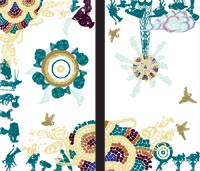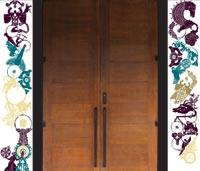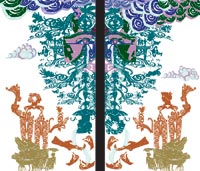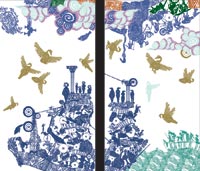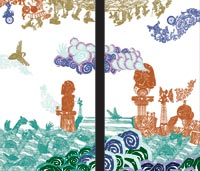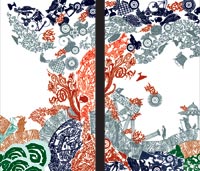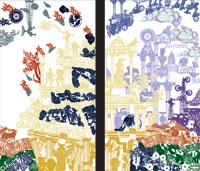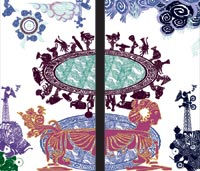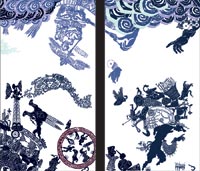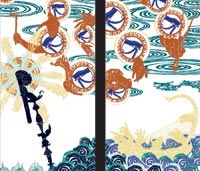Museum of Art Windows, Commons Area
My narrative occupies three walls of the UMMA Commons, a cafe lounge filled with small tables where students work and socialize through all hours of the day.
If the windows were chapters, the first portion of the sequence, facing an open courtyard, would be titled Origins...
Museum of Art Windows, Commons Area
My narrative occupies three walls of the UMMA Commons, a cafe lounge filled with small tables where students work and socialize through all hours of the day.
If the windows were chapters, the first portion of the sequence, facing an open courtyard, would be titled Origins. The laborer who mapped in circles and spirals the rotund surface of an Iron Age wine jug from Cyprus has been recruited here to describe the origin of the cosmos and the beginning of my narrative, the birth of time and space, in gestures lifted from that jug. Its intersecting circles form a force field holding everything that is and ever will be within its net.
In the next set of windows, that field has separated into angles and arcs, heaven and earth, dry land and water, embodied in the grammar of volutes and zigzags taken from a Seleucian architectural fragment. A flood of color spills into the adjacent seating space through patterns on a rounded geometric vase from ancient Thebes. Beginning here, transmissions are beamed from tower to tower along the sides of both museum buildings all the way to the front entrance of the Kelsey across the street, signals in a forever foreign language, persistently visible, sensed but never fully understood.
A colossal inverted human head straddles a doorway facing the courtyard. This forceful presence is cousin to the Yoruba mask in the museum galleries above--Egungun, the collective voice of the ancestors. My vinyl head has been assembled using fragments from the ancient Mediterranean world. Cultural essentials scrambled. Colonization reversed. Creatures swarm in its orbit, a teeming microcosm to honor and instruct.
The Great Voyage begins here. Migration by sea. Six hands from the painting galleries are setting forth on a Burmese harp. The harp navigates toward the corner of the building under a cluster of eyes that have floated free from the elaborately painted coffin of Djehutymose, priest at the temple of Horus at Edfu. Each eye is a sparkling fountain, each framed within a separate medallion, each medallion sprouting hands: pointing, reaching, cradling, teaching, clasping, writing, lifting, grasping, offering, touching, blessing.
The cloud of hands hovers high at the corner of the building, as if seeping onto the glass from the galleries above. A pool at the base of the building holds their accumulated sorrows. These are the tears of witnesses who know what is coming but are helpless to stop it. The hands have been plundered from the European and American collections inside, but also from South Asian sculptures, like the 10th century black schist figure of Vishnu, preserver of the universe and maintainer of cosmic order, who has several extra hands to spare.
Around the corner, calamity waits. A confluence of disasters inundates an isolated promontory: earthquake, cyclone, tsunami, invasion by incense censer and recumbent Aphrodite with whirling rotors. This was 1755 Lisbon. It is 2010 Fukushima. It will be 2055 New York. Out of sight, the constant changing of the earth, plates buckling, winds shifting, water racing and gathering into moving walls sweeping before them the sediment of human history. Change, constant change, visible and invisible, quiet and cataclysmic, carrying human culture in its wake.
A trail of refugees begins here. They turn from the destruction to follow a path up the window, carrying what they can salvage, migrating toward the chromatically more varied geography above. We can see what they cannot, that this new land is an inverted image of the doomed place they have left behind. An adjacent tree stands witness to the catastrophe of their migration. Inverted, its roots spread upwards into the archaeological layers protruding down from the architectural mass of the museum housing the collections that feed them. Beyond the tree, a new building project is being raised around a structural pillar of the museum. Viewers are then guided by way of transmission towers to the north face of the building, where they join a procession of refugees on their journey.

Scroll right to view more »
